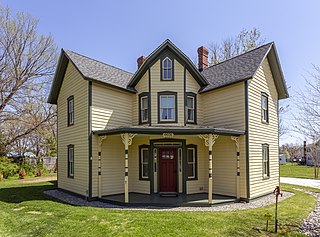
The Chesapeake Bay is the largest estuary in the United States. The Bay is located in the Mid-Atlantic region and is primarily separated from the Atlantic Ocean by the Delmarva Peninsula, including parts of the Eastern Shore of Maryland, the Eastern Shore of Virginia, and the state of Delaware. The mouth of the Bay at its southern point is located between Cape Henry and Cape Charles. With its northern portion in Maryland and the southern part in Virginia, the Chesapeake Bay is a very important feature for the ecology and economy of those two states, as well as others surrounding within its watershed. More than 150 major rivers and streams flow into the Bay's 64,299-square-mile (166,534 km2) drainage basin, which covers parts of six states, New York, Pennsylvania, Delaware, Maryland, Virginia, and West Virginia, and all of Washington, D.C.


Crisfield is a city in Somerset County, Maryland, United States, located on the Tangier Sound, an arm of the Chesapeake Bay. The population was 2,515 at the 2020 census. It is included in the Salisbury, Maryland-Delaware Metropolitan Statistical Area. Crisfield has the distinction of being the southernmost incorporated city in Maryland.

Maryland Route 335 is a state highway in the U.S. state of Maryland. The state highway runs 16.36 miles (26.33 km) from the upper end of Hooper's Island north to MD 16 in Church Creek. MD 335 provides access to several communities along the Honga River in southern Dorchester County. The state highway also passes through Blackwater National Wildlife Refuge. MD 335 was designated as one of the original state roads, but only the portion of the highway from Crossroads to the Blackwater River was completed by the early 1920s. The highway was constructed from Crossroads to Golden Hill in the mid-1920s, from Crossroads to Church Creek in the late 1920s, and from Golden Hill to Hooper's Island with the completion of a modern bridge over Fishing Creek in 1934.

The Hooper Island Light is a lighthouse in the Chesapeake Bay, west of Middle Hooper Island in Maryland.

Hooper Strait Light is one of four surviving Chesapeake Bay screw-pile lighthouses in the U.S. state of Maryland. Originally located in Hooper Strait, between Hooper and Bloodsworth Islands in Dorchester County and at the entrance to Tangier Sound, it is now an exhibit at the Chesapeake Bay Maritime Museum in St. Michaels, Maryland.

Taylors Island is an unincorporated community and census-designated place in Dorchester County, Maryland, United States, in the state's Eastern Shore region. The population was 173 at the 2010 census. It is known for hunting, crabbing and fishing. Ridgeton Farm was listed on the National Register of Historic Places in 1977. Bethlehem Methodist Episcopal Church and Grace Episcopal Church Complex were listed in 1979.

Holland Island was a marshy, rapidly eroding island in the Chesapeake Bay, in Dorchester County, Maryland, west of Salisbury. The island was once inhabited by watermen and farmers but has since been abandoned due to sinking of the land's surface associated with isostatic subsidence and sea level rise. It is located in the Holland Strait, between Bloodsworth Island and Smith Island, six miles west of Wenona, Maryland and Southeast of another former island, Long Island.

Phillips Foods, Inc. and Seafood Restaurants is a family owned and operated seafood company in the mid-Atlantic region, United States. Phillips Foods, Inc., seafood manufacturers as well as restaurateurs, specializes in crab meat and crab cakes, and produces a line of fish and shrimp products. The company is headquartered in Baltimore, Maryland. Phillips Seafood Restaurants have casual dining, buffet service and carryout.
Tangier Sound is a sound of the Chesapeake Bay bounded on the west by Tangier Island in Virginia, and Smith Island and South Marsh Island in Maryland, by Deal Island in Maryland on the north, and the mainland of the Eastern Shore of Maryland and Pocomoke Sound on the east. It stretches into Virginia as far south as Watts Island.
Carpenter Island (historical) is located on the southern end of the Chester River on Chesapeake Bay in Queen Anne's County, Maryland. It has been known as Carpenter Island or Carpenter's Island since the early 18th century.

Spesutie Island is a 1,500-acre (610 ha) island located in the Chesapeake Bay in Harford County, Maryland, United States. It lies 5.5 miles (8.9 km) southeast of Aberdeen, Maryland. Spesutie Narrows bounds the island on the west and the bay bounds it on the north, east, and south. The island is part of Aberdeen Proving Ground.

The Tilghman Watermen's Museum records the maritime traditions of the people of Tilghman Island and the unique way of life of the watermen who lived on the island. It is located on Tilghman Island, Talbot County, Maryland, United States.
The Ozinie, also known as the Wicomiss, were a group of Native Americans living near modern-day Rock Hall, in Kent County, Maryland. They were hunter-gatherers and fished.














